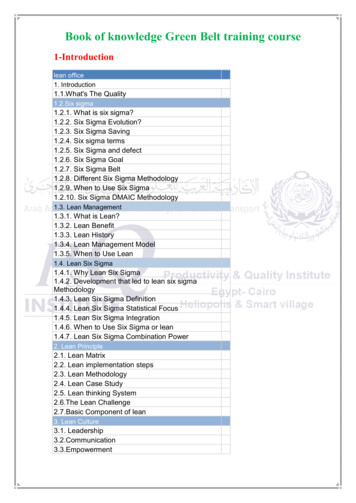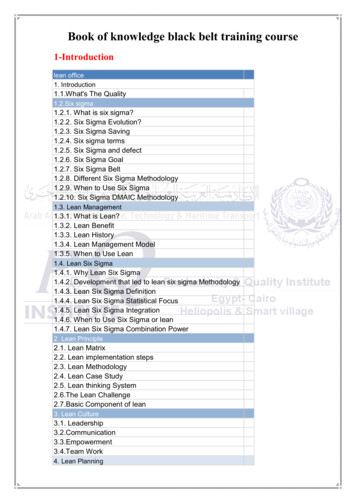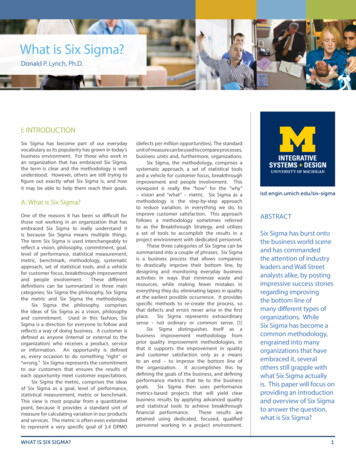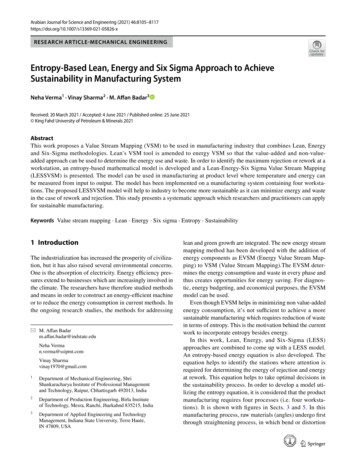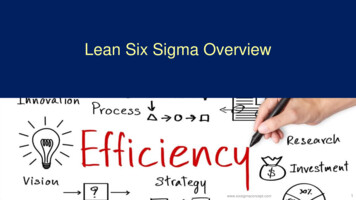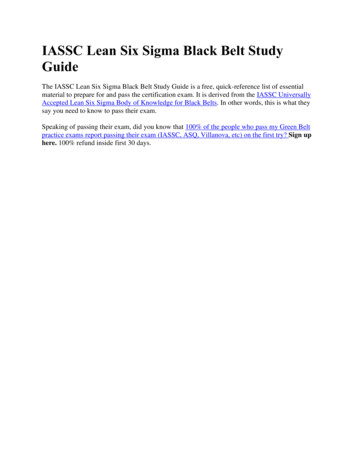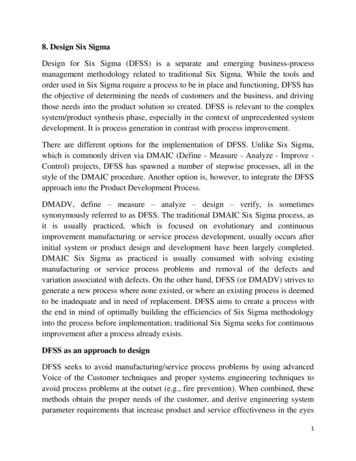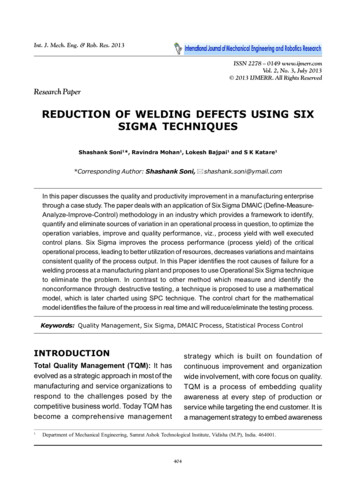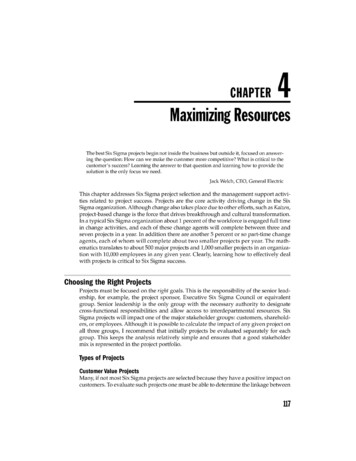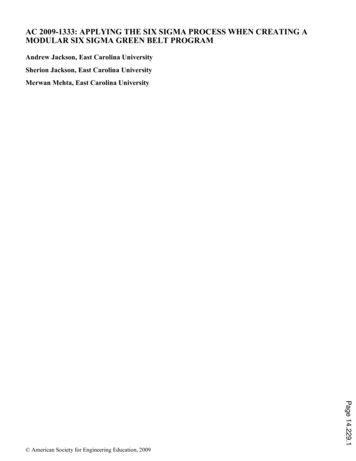
Transcription
AC 2009-1333: APPLYING THE SIX SIGMA PROCESS WHEN CREATING AMODULAR SIX SIGMA GREEN BELT PROGRAMAndrew Jackson, East Carolina UniversitySherion Jackson, East Carolina UniversityMerwan Mehta, East Carolina UniversityPage 14.229.1 American Society for Engineering Education, 2009
Applying the Six Sigma Process when Creating aModular Six Sigma Green Belt ProgramAbstractBusiness demand for Six Sigma educational programs has been on the rise the past several yearsand it appears that this trend will continue. In response to this demand from both industrial andacademic customers, the Department of Technology Systems at East Carolina University (ECU)developed a modular Six Sigma Green Belt (SSGB) course to deliver the Six Sigma body ofknowledge to customers. Since the Six Sigma process is also used in the development of finalproducts in manufacturing, it is anticipated that other researchers and academicians will benefitfrom the lessons learned in creating this training product.OverviewOnce the need for the modular Six Sigma Green Belt (SSGB) course was determined, the DMAICprocess most often used for Six Sigma projects was deployed. Tollgates to move from one phase ofthe process to another were utilized in managing the project. This process helped ensure that aneed to backtrack did not occur. The body of this paper describes each phase of the DMAICprocess along with an overview of how each phase was used to create the SSGB course product.Special notes for each phase and various tools that can be utilized during each phase have alsobeen included.A primary design goal for the project was to create a reusable set of curriculum materials that couldbe used in industrial short course environments or within collegiate academic programs of theTechnology Systems department at ECU. The idea was to be able to use the modules as parts ofanother course, or as stand-alone offerings. An example of this would be using the Theory ofConstraints (TOC) and the Lean Manufacturing module as part of an operations managementcourse, or utilizing the statistical quality control modules as stand-alone modules to teach howstatistics can be used for quality control. To keep the material manageable and interesting, it wasalso decided to design the modules so each one would last between 10 to 15 minutes.The initial phase of the program included the development of a core set of presentation materials byexperts in Six Sigma training. PowerPoint was the primary software tool used to generate a scriptfor these instructional materials. The notes section of each slide was utilized to create a monologuethat would be used throughout the development process to support both professional narration andclosed-captioning in order to broaden the prospective audience for the course. Student workers andgraduate assistants were employed to assist in mastering the course modules using audio voice-overrecordings and final product rendering using Camtasia .Page 14.229.2The completed modules and scripts were then reviewed by one or more subject matter experts toinsure error-free materials were provided to the next team member in a consistent style and format.The script for each slide was recorded by one of two communications students who wereinterviewed and selected from a group of five individuals recommended for the task by a seniorprofessor from the Department of Communication. The selected students brought a professionalstyle and quality to the process, while enhancing their portfolio for future employmentopportunities.
Once the presentation materials, audio files, and scripts were completed, the entire package of 52instructional chunks were mastered and rendered using Camtasia . The finished product wasreviewed one final time before the module was placed onto a Moodle course management sitewhere customers could review each module as needed throughout the course. For the first courseoffering the course was considered to be a blended Distance Education (DE) course. Even thoughexams were posted online, students had face-to-face interaction with the original content provider toaugment the online component of the course.The body of the paper further elaborates on the DMAIC process (Define, Measure, Analyze,Improve, and Control) and how it was utilized to create the final product. Hopefully, this will assistother academicians and trainers learn the DMAIC process and select appropriate tools from a crosssection of online educational learning components. The ultimate goal is to develop a trainingdelivery system that is flexible, responsive, and reliable.The Six Sigma ProcessSix Sigma is a quality management philosophy and methodology that focuses on improving thequality of processes, products, and services. Six Sigma relies on reducing defects through reductionin variation in all forms in products and processes. At the philosophical level, Six Sigma involveseveryone in the company in implementing continuous improvement processes. This is completedusing a wide variety of ideas and tools that are discussed in the following paragraphs.The overall structure of the Six Sigma process is shown in Figure 1. As specified in the acronymabove, the five phases that constitute the DMAIC process are: Define, Measure, Analyze, Improveand Control. The idea of keeping each phase distinct reinforces the concept that a formal reviewshall be conducted at the end of each phase. This process allows the team to move on to the nextphase only if all the requirements of the previous phase have been satisfactorily completed. This isdone to minimize the likelihood that some steps may have to be backtracked since they were notthoroughly completed. The executive project champion, the project manager, and the processimprovement team are all involved in the tollgate review.Figure 1. Six Sigma Phases of the DMAIC ProcessThe Define PhasePage 14.229.3In the define phase of the Six Sigma project, a clear definition of what needs to be achieved iscreated. At times a project is deployed to improve an existing process, and in such a case a logicalanalysis to determine the baseline for the process and corresponding issues that need improvementare identified. The customer or the final consumer for the product (or the process under
consideration) are crucial in the define phase as they help provide critical input. To achieve this,customers are interviewed at length to determine their exact requirements as a first step in creating asuccessful project. Also during the define phase, a project charter is created that defines theboundaries and limitations of the project to help prevent project creep as work progresses. Ideally, ateam is created who will stay together until the project is successfully completed. Based on theexperience of the project champion, who owns the project, and the project manager (who reports tothe project champion), a cross-functional team of people (who could contribute to the project duringvarious phases) is selected. Once the team has been selected, they will be deployed by the projectchampion. Activities & tools that are generally conducted during the define phase are: gap analysis,brainstorming, Nominal Group Technique (NGT), team building, high-level process mapping andvalue stream mapping. Creating a high sense of urgency in starting the project and moving on tosuccessive phases is also a prime activity that should be undertaken by the project champion.In pursuing the requirements of the define phase for the Six Sigma Green Belt Certificationprogram at ECU, the Dean of the College of Technology and Computer Science acted as theproject champion and the Director of the Center for Innovation in Technology and Engineering(CITE) Programs served as the project manager. A project team consisting of two facultymembers, and the Multimedia Consultant for the college was created.Through input from students and the advisory boards, a charter related to the kind of certificationprogram to be created was developed. In doing so, several other Green Belt certifications werestudied. Eventually, it was decided to create our Green Belt Certification Program utilizing bothlean and Six Sigma principles, not Six Sigma principles alone as do many leading certificationprograms, such as the American Society for Quality (ASQ).The Measure PhaseIn the measure phase of the DMAIC project, the idea is to gather as much data as possible in orderto shed light on the present state of affairs as the team establishes a process baseline. Various inputsand outputs are identified and baseline levels before improvement initiatives are implemented aremeasured. In the measure phase, the process sigma and the process capability for the specifiedprocesses are then calculated. Data are compiled and displayed graphically for ease of understandingby everyone involved in the process throughout the improvement initiative.PrimerSectionDescMod #9ModulesTopicsTopic DescriptionNumber ofslides1Lean thinking12Value23Value Stream2Introduction to4Value flow2Lean5Pull valve217Mistake proofing18Wastes819Theory of constraints9Slides inModuleDeliver22. . .TOC & DFSS1620DFSS16Figure 2. Sample Planning Map of the ModulesPage 14.229.4125
Activities and tools that may be utilized during the measure phase include: control charts,capability analysis, Pareto analysis, Affinity diagrams, check sheets and other data collectingmethods. A partial map of the Module layout (shown in Figure 2) defines some of therequirements derived during the DMAIC measure phase for the ECU Six Sigma Green BeltCertification project.The Analyze PhaseIn the analyze phase of the DMAIC process, key variables having an impact on the output areidentified and the root causes for the loss in productivity and or quality are determined. In theanalyze phase, the activities and tools that are likely to be undertaken are: 5-why analysis, causeand effect analysis, Failure Mode Effect Analysis (FMEA), graphical analysis, hypothesis testing,multi-variable analysis, correlation and regression analysis, mathematical modeling, and ANOVA(analysis of variation).For the Six Sigma Green Belt Certification project an analysis of the other certifications by variousuniversities and trade groups (e.g. the Society of Manufacturing Engineers (SME), AmericanSociety for Quality (ASQ), etc.) was conducted and through benchmarking the ideal body ofknowledge was determined. As stated earlier, many quality oriented organizations concentrate onSix Sigma principles and less so on lean manufacturing issues, but for the creation of our moduleswe opted for 45% lean concepts and tools and 55% Six Sigma.The Improve PhaseDuring the improve phase of the DMAIC process, the goal is to identify and test solutions that havebeen brainstormed and to then come up with a pilot “initial solution” that can be implemented.During this phase, the stress is also on determining optimum settings for various inputs so as to getthe best combination of the outputs. Once an initial solution is up and running, the next step is thento refine the solution through multiple kaizen events utilizing the skills of the process owners andoperators. After the process has stabilized, a cost benefit analysis is next conducted to see how muchimprovement the team has been able to capture. Activities and tools that are conducted during theimprove phase are kaizen events or kaizen blitzes, which are also called Rapid Improvement Events(RIE), implementation of the initial and the refined solution, and measurement of the impact ofimprovements.Page 14.229.5
Figure 3. Screen Shot of Powerpoint During Module CreationIn the Six Sigma Green Belt Certification project, the modules were developed and checked forerrors utilizing the skills of the faculty specializing in lean and Six Sigma principles. Thedevelopment of the modules was primarily conducted using PowerPoint as shown in Figure 3below. Moodle was the software used to organize and deliver the modules to students. A sample isshown in Figure 4.Figure 4. Screen Shot of Moodle Used for Organizing the ModulesThe Control PhaseDuring the control phase, plans on how the process team will now take the metrics of the process asPage 14.229.6In the control phase of the DMAIC process, the project plans have been implemented and theproject has been closed out and handed over to the day-to-day operators. Also, during this phasethe necessary systems and structures to maintain the process at the optimum levels should becreated. Plans to sustain the new process through constant monitoring and control should bedeveloped and implemented.
implemented as a new baseline. They shall then create and implement a system for continuousimprovement. During this phase, the assignment of responsibility & accountability for the processshould be done, and a time table to monitor process regularly should be created.Through brainstorming of the process team, the stages at which the process can be derailed shouldalso be identified in this phase and what action will be undertaken if an abnormal situation arose tothrow the process off track should be developed. Utilizing the concept of poke-yoke or mistakeproofing, how the process can be made robust is determined during the control phase and simplemeans to make the process self-correcting are implemented. Finally, project success in achieving thedefined goals of the project should be celebrated and the project team members should be showeredwith rewards and recognition to boost morale.The activities and tools that are undertaken in the control phase include creation of visual aids forvisual management, development of standard operating procedures, identifying and establishingcontrol mechanisms for effective monitoring of the process, and control plans using statistical meansto monitor that the process has only random variation and does not have any special causes to throwthe process out of track.In implementing the Six Sigma Green Belt Certification project, once the modules weredeveloped they were tried out extensively before hosting for the students. Also, a process toconduct a regular annual review was put into place with responsibilities assigned to specificindividuals who initially supported the development of the original product.ConclusionsOverall, the Six Sigma DMAIC process was successful in developing the Six Sigma Green BeltCertification. Six Sigma – through the DMAIC process – provides a definite method by which allprojects could easily be conducted. Using the DMAIC process helps eliminate the need to revisitphases of the project after the project has moved on to the next phase. This is accomplished bymoving the team thorough the evaluation scenarios by utilizing the toll gate process. By utilizing thesame methodology as we were using in our classes, this project avoided the trap of having to revisitearlier steps, thus allowing the team to stay away from expensive backtracking and redevelopmentcycles.After seeing the interest that the Six Sigma process has generated, the Six Sigma Green BeltCertification program has shown to be widely successful. An added benefit is that we have beenable to mix-and-match modules to create specific customized courses to meet additional trainingrequirements by industry constituents throughout the region. Furthermore, by incorporating online tests using the Moodle test bank function, students have been able to use the same softwareconfiguration, thereby minimizing adverse learning curve effects.Bibliography[2] Creveling, C. M., Slutsky, J. L., & Antis, D. (2003). Design for six sigma in technology and product development.Prentice Hall PTR, Upper Saddle, NJ.Page 14.229.7[1] Allen, T. A. (2006). Introduction to engineering statistics and six sigma: Statistical quality control and design ofexperiments and systems. Springer-Verlag, London.
[3] Gryna, F. M. (2001). Quality planning & analysis (4th Edition). McGraw-Hill Irwin, Boston, MA.[4] Gryna, F. M., Chua, R. C. H., & Defeo, J.A. (2007). Juran’s quality planning and analysis for enterprise quality.McGraw-Hill, Boston, MA.[5] Summers, D. C. S. (2006). Quality (4th Edition). Pearson Prentice-Hall, Upper Saddle River, NJ.[6] The Six Sigma Green Belt Primer. (April 3, 2006). Quality Council of Indiana. West Terre Haute, IN.Page 14.229.8
developed a modular Six Sigma Green Belt (SSGB) course to deliver the Six Sigma body of knowledge to customers. Since the Six Sigma process is also used in the development of f inal products in manufacturing, it is anticipated that other researchers and academ icians will benefit from the le
